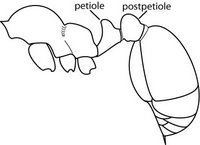 | ||
Similar Myrmicinae, Formicinae, Ponerinae, Dolichoderinae, Pheidole | ||
In entomology, petiole is the technical term for the narrow waist of some hymenopteran insects, especially ants, bees, and wasps in the order Apocrita.
Contents
The petiole can consist of either one or two segments, a characteristic that separates major subfamilies of ants.
Structure
The term 'petiole' is most commonly used to refer to the constricted first (and sometimes second) metasomal (posterior) segment of members of the hymenopteran suborder Apocrita (ants, bees, and wasps). It is sometimes also used to refer to other insects with similar body shapes, where the metasomal base is constricted. The petiole is occasionally called a pedicel, but in entomology, that term is more correctly reserved for the second segment of the antenna.
The plump portion of the abdomen posterior to the petiole (and postpetiole in the Myrmicinae) is called the gaster.
The structure of the petiole is an easy way to visually classify ants, because the major subfamilies of Formicidae have structural differences: some ants have two-segmented petioles, while others have a single-segmented petiole.
Other uses
Petiole may also be used in the context of wing veins, where a wing cell that is ordinarily four-sided is reduced to a triangle with a stalk (the cell thus being 'petiolate').
The stalk at the base of paper wasp nests is also called a petiole.
